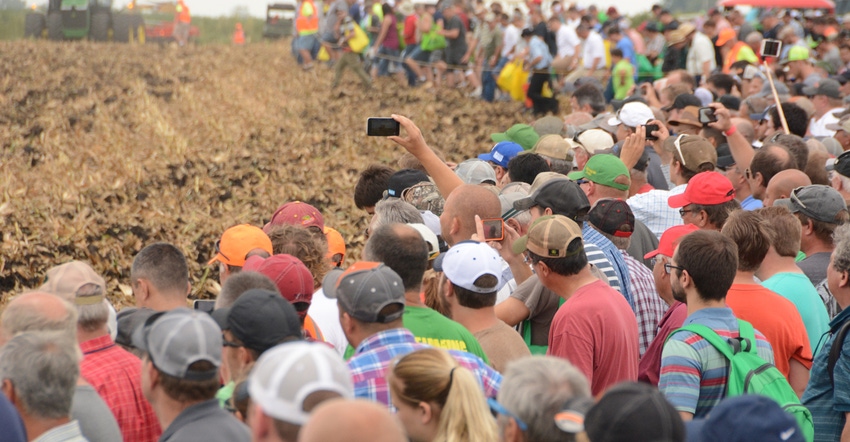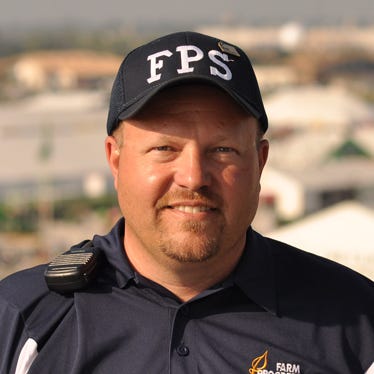
When the Farm Progress Show began in 1953, it was designed with a singular focus: Show farmers what equipment can really do in the field.
That’s still the motivation, says Matt Jungmann, national events director for Farm Progress, who coordinates the nation’s largest outdoor farm show — complete with the largest field demonstration area in the U.S.
Farm Progress publication Prairie Farmer caught up with Jungmann for a look at what farmers will find beyond the exhibit field at this year’s Farm Progress Show in Boone, Iowa, and what it takes to make it all happen.
What will we see in the field this year? Well, on your way to the field demos, the tram loading area will be bracketed by more Ride ’n’ Drives than ever before. We have Ride ’n’ Drives from all major manufacturers. Case IH, John Deere and Agco will have several new pieces. We’ll also have a couple Ride ’n’ Drives with people you’ve come to expect, like Titan with their new low-sidewall technology, the Detroit companies with new pickups, and all the ATV and UTV companies.
Ride ’n’ Drive sounds bigger? Yes! Companies want to put people in the cabs, and we’re allocating a lot more area than ever before in Boone. Each one is a little over an acre, so there could be 10 acres’ worth of driving courses.

MORE AND BETTER: “We’ve never had interest in Ride ’n’ Drives like we’ve had this year,” says Matt Jungmann.
With all the obstacles they create, what’s it take to put together a Ride ’n’ Drive demo field? The companies always want to do more, and we limit them, to a degree. They want to bring in cinder blocks and big chunks of limestone, but we have to remember the farmer wants to raise corn there next year. So we don’t let them put wood chips down because that ties up nitrogen for next year’s crop. We give them parameters for the course, and they bring things like railroad ties — things they can pick up and clean up, but that they can use to show off suspension. Then once they’re done, we can run a deep ripper, and the farmer is good to go for next year’s crop.
Beyond the Ride ’n’ Drives, what’s out there in the field demos? You’ll see combines and head companies competing side by side. It kicks off with harvest demos at 11 a.m.; then we’ll re-rack and do the same field with tillage at 1 p.m. The standard deep-tillage machines are always popular, but these new high-speed European-inspired units — that category grows every year. With Kinze entering the market, there are a lot of new things to see out there.
What’s it take to get field demos ready to roll? Typically, we have a rectangular 80[-acre area] for each day of the show. Ahead of the show, we pull off end rows, we pull off the whole Ride ’n’ Drive area, and we pull off the staging area. Of the 360 acres of corn we start with, we have 200 acres left standing come showtime — and those fields are tuned up and ready to go on show morning. Obviously, all that is Mother Nature-dependent; sometimes we’re out there until midnight [the night before] getting ready to go.
What are they doing to prepare? In an ideal world, it starts Thursday or Friday before the show. It’s a tight, compact time, and it’s hectic Friday, Saturday and Sunday for equipment people and our field crew. They’re trying to get them enough acres so they can tune machines but protect enough corn for demos on Tuesday morning. There’s a delicate balancing act that weekend. And it’s high pressure for those company guys — they want to make it work right.
Tell us about tiling demos. Tiling demonstrations are new to Boone this year. Timewell Drainage Products and Hol Drainage have designed a drainage system for the northeast 220 acres. They’ll do a third this year, a third in 2020, and a third in 2022. Craig Hol at Hol Drainage has poured a ton of work into this project.
Between combine demos at 11 a.m. and tillage at 1 p.m., we’ll give visitors something to watch over noon: an hour of in-field tiling. We’re putting in mains and laterals, in an intensive grid tiling program. Six Timewell contractors will install 3-inch tile on 40-foot lateral spacings.
It’s taken a lot of coordination between Timewell and Hol Drainage, plus several other Timewell contractors and the host farmers, Central Iowa Expo, and Farm Progress. Everybody’s doing their part to make this a really cool feature. And it’s good for the site, too, for handling Mother Nature’s possible impacts.
Hosted by Farm Progress publication Wallaces Farmer, the Farm Progress Show will be held in Boone, Iowa, Aug. 28-30.
About the Author(s)
You May Also Like






